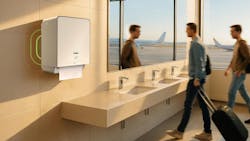Smarter Restrooms, Smoother Operations: Why Smart Restrooms Matter in Aviation

In a fast-paced travel environment, airports are under constant pressure to deliver seamless, hygienic and efficient passenger experiences. While much attention is given to security, check-in and boarding processes, one of the most telling indicators of an airport’s operational excellence is the restroom. Increasingly, smart restroom technology is becoming a must-have solution for hygiene, labor optimization and improved visitor experiences in the aviation industry.
What You Will Learn
This article explores how technology is revolutionizing restroom management in airports. You’ll discover:
- Why hygiene has become a top priority in public spaces, especially in aviation
- What smart restroom technology is and how it works
- The key operational and customer experience benefits of implementing smart restroom systems
- Real-world examples of smart restroom solutions and practical considerations for integrating these systems into your facility
For those curious about the airport infrastructure of the future, this article provides valuable insights into how smart restrooms will factor in and why they matter.
Transforming Cleanliness, Operations & More
In the world of airport operations, every square foot of terminal space is expected to perform. From check-in counters to baggage claims, efficiency and experience are paramount. Yet one of the most critical and often overlooked areas for innovation is the restroom. As passenger volumes rise and expectations for cleanliness and convenience grow, airports are turning to smart restroom technology to modernize facility management, reduce operational strain and improve traveler satisfaction.
The Rise of Public Hygiene Consciousness
Today's guests are more hygiene-conscious than ever before. This shift has been ongoing and predates the global COVID-19 pandemic which strongly reinforced our collective germ awareness. Cleanliness has become a top priority in daily life – especially in highly visited public restrooms. A clean, well-maintained restroom is no longer a luxury, but a necessity for patron well-being and facility reputation.
Restrooms are among the most frequently used spaces in any airport. They’re also one of the most visible indicators of how well a facility is managed. A clean, well-stocked restroom can leave a lasting positive impression while a poorly maintained one can lead to complaints, negative reviews and even health concerns.
For aviation facility managers, maintaining consistent restroom standards across terminals, concourses and lounges can be a challenge due to fluctuating traffic patterns, staffing constraints and tight budgets. These complex maintenance needs present a unique opportunity for those in facility management positions to invest in transformative smart building technologies.
Interconnected restroom solutions can help airport staff meet elevated hygiene demands, ensure consistency and enhance visitor satisfaction. It can support more positive impressions of your airport overall and, by extension, of your city at large.
What Is Smart Restroom Technology?
Smart restroom systems use connected sensors and cloud-based platforms to monitor real-time conditions such as:
- Soap, sanitizer and paper product levels
- Cleaning schedules and service alerts
- Foot traffic and fixture performance
This data is then used to trigger alerts, generate reports and guide custodial teams to where they’re needed most—eliminating unnecessary manual dispenser checks and helping ensure that restrooms stay clean, stocked and operational.
Key Smart Restroom Benefits for Airports
1. Labor Optimization
Smart systems help custodial teams work efficiently by focusing efforts where they’re needed most. This is especially valuable in large terminals where staffing resources are stretched thin. Rather than relying on fixed schedules, smart systems may also enable predictive servicing by anticipating when supplies will run low or when usage spikes are likely to occur.
2. Improved Passenger Experience
On a busy travel day or during a quick layover, an airport visitor may only have a few minutes on the ground before they’re down the jetway again. They don’t have time to wait in line for the restroom due to stall closures or empty dispensers. Clean, well-maintained restrooms contribute directly to traveler satisfaction scores and reduce the volume of complaints in a sometimes high-stress environment.
3. Sustainability
Smart restrooms help support environmental goals by minimizing waste and optimizing resource usage. By monitoring real-time usage patterns, smart restrooms streamline cleaning schedules so that staff clean only when needed—helping avoid unnecessary product waste from discarding supplies that haven’t been fully used. This data-driven approach not only helps conserve resources, but also aligns with broader sustainability initiatives that your airport might be adopting.
4. Cost Savings
Airport facility managers can use this technology to shift from rigid, time-based maintenance routines to a dynamic, data-driven approach. This enables more efficient operations and cost savings through:
- Minimized passenger complaints by proactively addressing low-supply alerts before dispensers run empty.
- Reduced product waste by eliminating unnecessary restocking of partially used supplies.
- Smarter staff deployment, ensuring custodial teams are focused where and when they’re most needed—especially during peak travel times.
- Optimized labor scheduling, which can help lower turnover by reducing burnout and improving job satisfaction—ultimately cutting recruitment and onboarding costs.
- Early detection of dispenser malfunctions, allowing for timely repairs that reduce downtime, avoid costly service disruptions and enhance traveler satisfaction.
Harnessing the Power of Data in Aviation Facilities
Many airports, large and small, are beginning to integrate smart restroom technology into their broader digital transformation strategies. These systems are often part of a larger push toward smart building infrastructure where data is used to optimize everything from HVAC to lighting to janitorial services.
When exploring smart restroom technology options, most airport executives are on the lookout for the following features:
Seamless Integration: The best smart restroom tech options seamlessly integrate with existing systems via open APIs to maximize efficiency and data accuracy.
Scalability: A scalable solution that can adapt to varying traffic volumes and seasonal changes helps ensure its effectiveness as your facility evolves.
User-Friendly Technology: Choosing technology that is intuitive and easy to use for both management and janitorial staff minimizes training time and ensures smoother adoption.
Cost-Benefit Analysis: Decision makers should always assess the long-term fiscal impact of integrating smart restroom technology, including the savings it could generate.
A Real-World Example
Onvation® Smart Restroom Management System by Kimberly-Clark Professional is a smart restroom innovation designed for high-traffic environments like airports. Onvation provides real-time visibility into restroom conditions, going beyond traditional restroom management approaches. In the arena of smart restroom technology, Ovation offers a strategic solution for optimizing facility management in high-traffic venues amid evolving industry expectations.
Key Onvation Benefits
- Monitors restroom conditions and supply levels
- Reduces wait times and enhances travel experiences
- Supports sustainability goals by using real-time data to optimize resource usage and minimize waste
- Seamlessly integrates with existing systems via an Open API framework for greater adoption
- Uses data to help facility managers address changing traffic volumes for greater operational efficiency
Bottom of Form
As airports continue to evolve into smarter, more connected environments, the restroom is emerging as a strategic space for innovation. With the right technology, facility managers can turn a traditional pain point into a powerful tool for operational excellence and passenger satisfaction.
About the Author

Karen Ross
Business Operations Leader, Onvation
Karen Ross is a seasoned innovation and operations leader at Kimberly-Clark Professional, currently heading business operations for Onvation®, the company’s smart restroom software solution. With nearly 20 years of experience across R&D, product development, and brand management, Karen has led major initiatives for brands like Scott®, Cottonelle®, and Huggies®. She’s known for her ability to bridge technical innovation with strategic business growth. Karen holds a chemical engineering degree from Penn State and has mentored future engineers through programs including Georgia Tech’s MSE program.